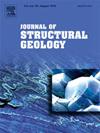Kinematic interpretation of the Cañamares shear zone (central Iberian zone, Iberian Massif): from late Variscan strike-slip tectonics to Alpine deformation
IF 2.9
2区 地球科学
Q2 GEOSCIENCES, MULTIDISCIPLINARY
引用次数: 0
Abstract
The Cañamares shear zone is located at the eastern end of the Spanish-Portuguese Central System, in the Central Iberian Zone of the Iberian Massif. It is a dextral transpressive structure, generated during the third Variscan deformation stage (D3: 318-300 Ma), which was later reworked during the Permian and by Alpine tectonics. Once the local effects of later phases have been eliminated, the kinematic analysis of the Cañamares shear zone shows that it is a structure due to a monoclinic to slightly triclinic flow, with a vorticity dominated by the simple-shearing component (Wk > 0.81). The convergence direction of the blocks separated by the shear zone would have been N160°E to N-S. The convergence direction calculated for the Cañamares shear zone differs from that of other D3 shear zones of the Iberian Massif. A comparison between these vectors would help to better understand the complexities of the final phases of the Variscan Orogeny in Iberia. However, the Cañamares shear zone lies at the core of an Alpine mega-fold and its current orientation does not probably reflect its primary geometry.
Cañamares剪切带(伊比利亚中部带,伊比利亚地块)的运动学解释:从晚瓦里斯坎走滑构造到阿尔卑斯变形
Cañamares剪切带位于西班牙-葡萄牙中央体系的东端,位于伊比利亚地块的伊比利亚中部地区。它是一个右向逆压构造,形成于第三个瓦里斯坎变形阶段(D3: 318-300 Ma),后来在二叠纪和高山构造中被改造。一旦排除了后期阶段的局部影响,Cañamares剪切带的运动学分析表明,它是一个由单斜到微三斜流动引起的结构,涡度由单剪切分量主导(Wk >;0.81)。被剪切带分隔的块体辐合方向为N160°E到N-S。Cañamares剪切带的辐合方向与伊比利亚地块其他D3剪切带的辐合方向不同。这些载体之间的比较将有助于更好地理解伊比利亚瓦里斯坎造山运动最后阶段的复杂性。然而,Cañamares剪切带位于阿尔卑斯巨型褶皱的核心,其目前的方向可能并不反映其原始几何形状。
本文章由计算机程序翻译,如有差异,请以英文原文为准。
求助全文
约1分钟内获得全文
求助全文
来源期刊

Journal of Structural Geology
地学-地球科学综合
CiteScore
6.00
自引率
19.40%
发文量
192
审稿时长
15.7 weeks
期刊介绍:
The Journal of Structural Geology publishes process-oriented investigations about structural geology using appropriate combinations of analog and digital field data, seismic reflection data, satellite-derived data, geometric analysis, kinematic analysis, laboratory experiments, computer visualizations, and analogue or numerical modelling on all scales. Contributions are encouraged to draw perspectives from rheology, rock mechanics, geophysics,metamorphism, sedimentology, petroleum geology, economic geology, geodynamics, planetary geology, tectonics and neotectonics to provide a more powerful understanding of deformation processes and systems. Given the visual nature of the discipline, supplementary materials that portray the data and analysis in 3-D or quasi 3-D manners, including the use of videos, and/or graphical abstracts can significantly strengthen the impact of contributions.
 求助内容:
求助内容: 应助结果提醒方式:
应助结果提醒方式:


